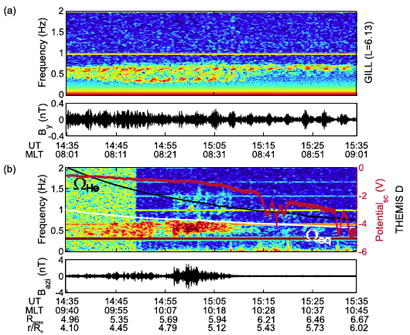Inner Magnetosphere
Thanks to their unique observational capabilities, the Cluster and IMAGE missions have renewed interest in the inner magnetosphere region and its triumvirate: the plasmasphere, the ring current and the radiation belts. An entire afternoon session was dedicated to this region. The session started with a presentation of highlights obtained by IMAGE and Cluster and opportunities offered by THEMIS and CARISMA.
Using data from Cluster and IMAGE, new results were presented on plasmaspheric plumes and ELF/VLF whistler-mode waves in the outer plasmasphere. Such waves play an important role in the loss of relativistic electrons from the radiation belts. A similar role is attributed to electromagnetic ion cyclotron (EMIC) waves, created by ring current ions and observed in the Ultra Low Frequency (ULF) range, most specifically in the Pc1-Pc2 range (0.1-5 Hz).
Simultaneous THEMIS-CARISMA observations of EMIC Pc1 waves (see Figure 1) were presented. The analysis of these data led to the conclusion that solar wind density enhancements play a role in the excitation of these waves in a radially localised region near the plasmapause. This location was, until now, thought to be confined to higher L-shells (Usanova et al., 2008). Good agreement was found between ULF waves, observed in the 4-25 mHz range (Pc3-Pc4 type) from the magnetopause to the plasmapause, and recent models.
Changes in the large-scale convection electric field change the plasmaspheric configuration thus, for instance, changing the locations where whistler-mode and EMIC waves occur. New results were presented on storm time electric fields deduced from 5 years of Cluster data.
Over the coming years, the so-called "chase for whistlers" will be on. The three innermost THEMIS satellites, together known as THEMIS-Low, will be set to trigger their burst mode in the inner magnetosphere according to wave activity level. This will enable the instruments to capture high-resolution wave and particle data in the vicinity of, or even within, source regions of whistler-mode waves. Meanwhile, the lower perigee of Cluster in the course of its extended phase will allow high-resolution measurements deeper in the plasmasphere.
Related paper
Usanova, M. E., et al., "Multipoint observations of magnetospheric compression-related EMIC Pc1 waves by THEMIS and CARISMA", Geophys. Res. Lett., 35, L17S25, 2008, DOI:10.1029/2008GL034458.


